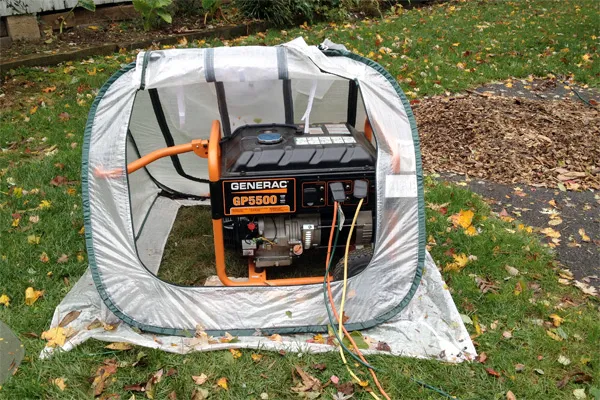
Picture this: a sudden storm rolls in, the lights flicker and go out, and your trusty generator kicks in, humming to life like a hero. But wait, what’s that? Water pooling near the engine, debris stuck in the vents, rust starting to form. That reliable generator just took a hit, and not from overuse but from exposure. If you’ve ever relied on a generator during a power outage, camping trip, or emergency, you already know it’s a lifeline. But like any lifeline, it needs protection. And yet, the generator cover is one of the most overlooked essentials when it comes to home preparedness or outdoor power use. Many people spend hundreds (or even thousands) on a generator, only to toss a tarp over it or leave it exposed. The result? Decreased performance, higher maintenance costs, and a significantly shorter lifespan.
It doesn’t just keep your machine dry it protects it from dust, UV rays, rodents, snow, and even bugs. But not all covers are created equal. With so many options on the market, how do you know which one actually gets the job done? This guide will cut through the noise to help you find the right cover generator for your needs without the fluff or gimmicks. Whether you’re a homeowner, camper, or prepper, you’ll walk away knowing exactly what to look for and what to avoid.
Why You Need a Generator Cover
Let’s start with the basics. A cover generator protects your investment. Simply as that. These machines are built to last, but only when treated right. Rain, dust, snow, and sunlight can wreak havoc on the engine, wiring, and components. Over time, moisture leads to rust, UV rays crackthe plastic housing, and small debris can clog air intakes.
Key Benefits:
- Weather Protection: Shield from rain, snow, hail, and wind.
- UV Defense: Prevents cracking, fading, and internal heat damage.
- Peace of Mind: You’re ready for any blackout or emergency with a well-maintained machine.
A cover is a small price to pay for uninterrupted power and long-term reliability.
Types of Generator Covers
Not all covers are created equal.
1. Storage Covers
These are intended for long-term storage, either indoors or outdoors.
Best For:
- Seasonal users
- Home backup generators
- Indoor storage with dust protection needs
2. Running Covers
Yes, there are covers designed for when the generator is in use! These have openings for air intake, exhaust, and controls, keeping it protected while running during bad weather.
Best For:
- Outdoor emergencies
- RV and camping trips
- Hurricane season prep
3. Canopy-Style Covers
These create a tent-like enclosure, ideal for portable generators that need overhead protection while running.
Best For:
- Outdoor events
- Job sites
- Portable power use in rain or snow
What a Generator Cover Should Have
When shopping for the right cover, keep an eye on these critical features:
1. Material Quality
Durability matters. Look for tear-resistant, waterproof materials like 600D polyester with PVC coating. Double-stitched seams and elastic hems are a bonus.
2. Ventilation
A cover should breathe. Without proper air circulation, moisture builds up underneath and leads to mold or rust.
3. Fit and Size
One size doesn’t fit all. Measure your generator and buy a cover that allows a snug but not tight fit. Too tight, and you’ll struggle to remove it.
4. Accessibility
Zippered panels or Velcro flaps make it easier to access your generator’s controls and outlets without fully removing the cover.
5. Heat Resistance (for Running Covers)
If the generator will run while covered, ensure the material is heat-rated and the design allows safe ventilation for exhaust and engine heat.
Top Mistakes to Avoid
Let’s be honest most people buy a cover once, and forget about it. But a bad purchase can do more harm than good. Avoid these common pitfalls:
- Using a tarp: Tarps trap moisture and aren’t designed for airflow.
- Cheap material: Thin plastic or low-quality fabric will tear within a season.
- Running with a storage cover: This is dangerous and can cause overheating or fire.
Best Generator Cover Brands to Consider
While we’re not here to sell, a few brands consistently earn praise for quality and durability:
- GenTent – Best for running covers with patented canopy designs.
- IGAN – Popular for affordable, weatherproof running covers.
- Champion & Honda – Offer custom covers tailored to their own models.
DIY Generator Cover: Worth It?
Some handy folks build their own covers using PVC pipe and tarp. While that might work short-term, it usually lacks the ventilation, portability, and durability of commercial products. Unless you’re an expert builder, a well-reviewed store-bought option will offer better safety and performance.
In the end, choosing the right generator cover might not seem exciting but it’s a decision that pays off big when disaster strikes. Think of it like insurance for your power supply. You wouldn’t leave your car in a hailstorm without protection, so why do it to your generator? Whether you’re bracing for hurricane season or heading into the woods, the right cover means your generator is always ready, clean, dry, and running smoothly. Take the time, do the research, and pick a cover that fits your lifestyle and your machine.
